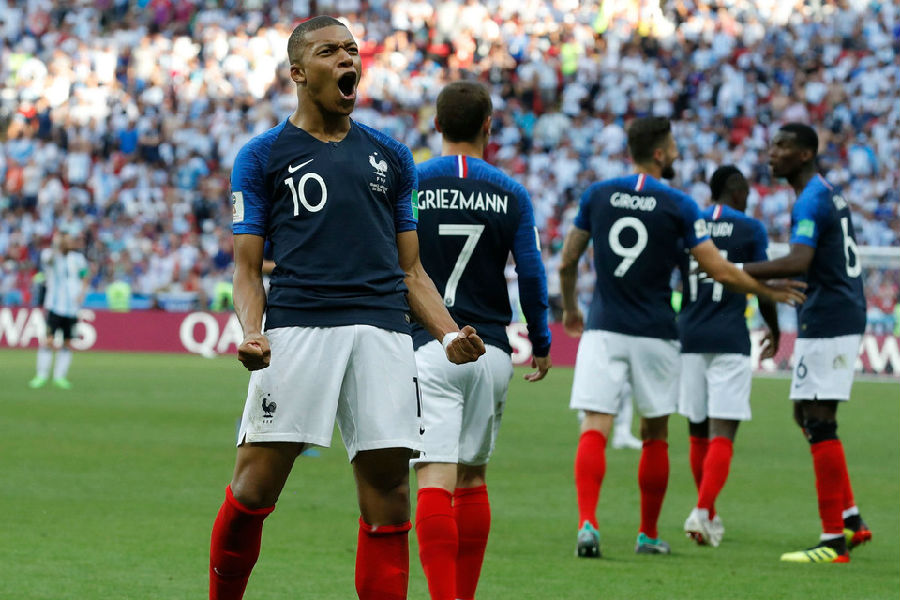(单词翻译:单击)
In 1998, the French national team, called Les Bleues, won the World Cup.
1998年,法国国家队,人称“蓝色军团”,夺得了世界杯冠军。
A moment that was celebrated throughout the country.
这是一个举国欢庆的时刻。
And it seemed to be a breakthrough for French multiculturalism as well,
这一时刻不仅是法国足球的突破,似乎也象征了法国多元文化的一次突破,
since several players were either immigrants themselves
因为有些队员要么自己是移民,
or children of immigrants who came to France in the 20th century.
要么父辈是20世纪的法国移民。
The team was called the “Black, Blanc, Beur”, meaning “black, white, arab” -
那时法国队还有一个外号“Black,Blanc,Beur”,意思是“黑色,白色,阿拉伯色” -
a spin on the three colors of the French flag.
其灵感来源于法国国旗上的三种颜色。
But not everyone supported diversity, particularly nationalist politicians like Jean-Marie Le Pen.
然而,不是每个人都支持多样性,尤其是像让·玛丽·勒庞这样的民族主义政治家。
Despite racist criticism, players from immigrant families have continued to make up more and more of France’s best talent.
尽管遭到了种族主义的批判,移民家庭仍在为法国队输送最优秀的人才。
Many come from one place in particular.
而且很多人都来自一个地方。
38% of immigrants to France settle in Greater Paris.
38%的法国移民都定居在大巴黎地区。
Most end up in these areas called banlieues.
大多数人最终都落户在了所谓的banlieues。
The French word literally means “suburb”; but it can also imply immigrant-dominated ghettos.
这个法语单词的字面意思是“郊区”;但也可以用来指移民占多数的贫民窟。
Over the years, these areas have frequently seen riots.
多年来,这些地区经常发生骚乱。
They have high levels of unemployment, crime, and poverty and are in a crisis.
失业率,犯罪率和贫困率都居高不下,还面临着一场危机。
Yet the banlieues continue to produce some of the most talented soccer players.
然而,这里还在继续诞生最具才华的足球运动员。
That’s because this is where France’s immigration history meets its soccer system,
这是因为这里是法国移民史和法国足球体系相遇的地方,
and it’s the reason why the city is the world’s number one talent pool for soccer.
这也是为什么这个城市是世界头号足球人才库的原因。
Since 2002, the number of Parisian-born players at the World Cup has continued to rise.
自2002年以来,世界杯上巴黎出生的球员人数一直在持续增加。
Out of all French players at the 2018 World Cup (50), 16 were born or raised in Greater Paris.
在2018年世界杯的所有(50名)法国球员中,有16位是在大巴黎出生或长大的。
The French national team has eight from banlieues, all children of immigrants.
法国国家队有八个来自这个郊区,而且他们都来自移民家庭。
That includes Kylian Mbappe, France’s 19 year-old super star
其中就包括19岁的超级明星基利安·姆巴佩
who was born to an Algerian mother and Cameroonian father in the Parisian suburb of Bondy
姆巴佩出生在巴黎郊区的邦迪,母亲来自阿尔及利亚,父亲则来自喀麦隆,
and was trained through the French system at Clairefontaine.
受训于法国足球青训基地克莱枫丹。
But Parisian players don’t just play for France.
然而,巴黎的球员们并不只会为法国效力。
Over the years, FIFA’s eligibility rules have allowed them to play for countries like the Ivory Coast, Morocco, Algeria, Portugal, Cameroon, and Togo.
多年来,根据国际足联的规定,他们得以为象牙海岸、摩洛哥、阿尔及利亚、葡萄牙、喀麦隆和多哥等多个国家效力。
4 players on this year’s Senegal team are from the Greater Paris area as well as this player on Tunisia.
今年有4名塞内加尔队球员,还有这名突尼斯队的球员都来自大巴黎地区。
And remember this photo? Both of these players were born in Paris.
还记得这张照片吗?这两位球员都出生在巴黎。
That’s what’s special about French soccer -
这就是法国足球的特别之处 -
the combination of an established academy system and its unique immigration history is producing incredible talent -
正式的培养体制,加上其独特的移民历史,正孕育着了不起的人才 -
for France and the rest of the world.
为法国,也为全世界。


